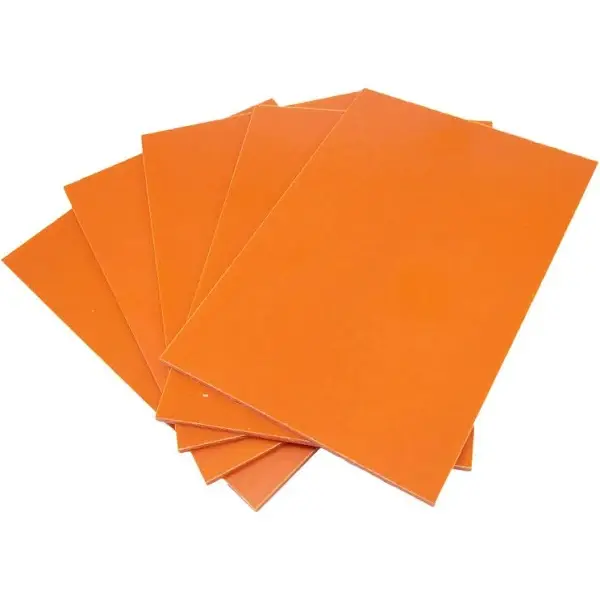Phenolic Paper vs G10 Sheet: Key Material Differences
Phenolic paper sheets and G10 sheets are both widely used composite materials in various industries, but they possess distinct characteristics that set them apart. Phenolic paper sheets, made from paper impregnated with phenolic resin, offer excellent electrical insulation and mechanical properties at a lower cost. G10 sheets, composed of woven glass fabric and epoxy resin, provide superior strength, dimensional stability, and moisture resistance. The choice between these materials depends on specific application requirements, with phenolic paper excelling in cost-effective electrical insulation and G10 shining in high-performance mechanical applications. Understanding their unique properties is crucial for selecting the optimal material for industrial equipment and components.

What Distinguishes Phenolic Paper from G10 in Composition and Strength?
Raw Material Composition
Phenolic paper sheets are fabricated using layers of paper impregnated with phenolic resin. This combination results in a material that balances cost-effectiveness with reliable performance. The paper substrate provides a base structure, while the phenolic resin imparts strength and insulating properties.
G10 sheets, conversely, utilize a glass fabric substrate combined with epoxy resin. This composition yields a material with enhanced strength and durability. The woven glass fibers contribute to superior mechanical properties, while the epoxy resin ensures excellent bonding and chemical resistance.
Manufacturing Process
The production of phenolic paper sheets involves layering phenolic resin-impregnated paper sheets and subjecting them to heat and pressure. This process, known as thermosetting, creates a rigid, irreversible bond between the layers, resulting in a homogeneous material with consistent properties throughout its thickness.
G10 sheets undergo a similar manufacturing process, but with glass fabric layers instead of paper. The epoxy resin is applied to the glass fabric, and the layers are then compressed and cured under controlled temperature and pressure conditions. This process results in a dense, void-free material with exceptional strength and dimensional stability.
Strength Characteristics
Phenolic paper sheets exhibit good mechanical strength, making them suitable for various electrical and industrial applications. They offer reliable performance in terms of compressive strength and impact resistance. However, their strength properties are generally lower compared to G10 sheets.
G10 sheets boast superior strength characteristics due to their glass fabric reinforcement. They demonstrate exceptional tensile, compressive, and flexural strength, outperforming phenolic paper sheets in high-stress applications. The glass fibers provide enhanced rigidity and resistance to deformation under load.
Mechanical, Thermal, and Electrical Property Comparison
Mechanical Properties
Phenolic paper sheets offer good machinability and can be easily cut, drilled, and shaped using standard tools. They possess moderate impact resistance and are suitable for applications requiring moderate mechanical stress. Their dimensional stability is adequate for most general-purpose uses.
G10 sheets excel in mechanical properties, exhibiting high tensile and compressive strength. They maintain excellent dimensional stability across a wide range of temperatures and environmental conditions. G10's superior impact resistance and low creep make it ideal for high-performance mechanical applications.
Thermal Properties
Phenolic paper sheets demonstrate good heat resistance, typically withstanding temperatures up to 120°C continuously. They maintain their structural integrity and electrical properties at elevated temperatures, making them suitable for various electrical insulation applications.
G10 sheets offer enhanced thermal performance, with continuous operating temperatures reaching up to 155°C. They exhibit low thermal expansion and excellent dimensional stability under thermal stress, making them ideal for applications involving temperature fluctuations.
Electrical Properties
Phenolic paper sheets are renowned for their excellent electrical insulation properties. They provide high dielectric strength and low dielectric loss, making them suitable for various electrical and electronic applications. Their performance in high-humidity environments is generally good but may be slightly inferior to G10.
G10 sheets offer superior electrical insulation properties, with higher dielectric strength and lower dielectric loss compared to phenolic paper sheets. They maintain excellent electrical properties even in high-humidity conditions, making them ideal for demanding electrical and electronic applications.
Selecting the Right Material for Industrial Equipment
Application-Specific Considerations
When choosing between phenolic paper and G10 sheets for industrial equipment, it's crucial to consider the specific requirements of the application. Phenolic paper sheets are often preferred in applications where cost-effectiveness is a priority and moderate mechanical and electrical properties suffice. They excel in general-purpose electrical insulation, switchgear components, and transformer insulation.
G10 sheets are the material of choice for applications demanding high mechanical strength, superior electrical properties, and excellent dimensional stability. They are commonly used in aerospace components, high-performance circuit boards, and precision mechanical parts where reliability under extreme conditions is paramount.
Environmental Factors
Environmental conditions play a significant role in material selection. Phenolic paper sheets offer good resistance to moisture and chemicals, making them suitable for many industrial environments. However, in extremely humid or chemically aggressive settings, their performance may be compromised.
G10 sheets exhibit exceptional resistance to moisture, chemicals, and environmental degradation. They maintain their properties in harsh environments, including exposure to oils, solvents, and saltwater. This makes G10 an excellent choice for marine applications, chemical processing equipment, and outdoor electrical installations.
Cost-Benefit Analysis
Cost considerations often influence material selection in industrial applications. Phenolic paper sheets generally offer a more economical solution, making them attractive for large-scale production or applications where cost reduction is crucial. Their lower cost does not significantly compromise performance in many standard applications.
G10 sheets, while more expensive, provide superior performance and longevity in demanding applications. The higher initial cost is often offset by reduced maintenance, longer service life, and improved reliability in critical components. For high-value equipment or applications where failure is not an option, the investment in G10 can be justified by its exceptional properties and durability.
Conclusion
The choice between phenolic paper sheets and G10 sheets depends on a careful evaluation of application requirements, environmental conditions, and cost considerations. Phenolic paper sheets offer a cost-effective solution with good electrical and mechanical properties, suitable for many general-purpose applications. G10 sheets provide superior strength, stability, and performance in demanding environments, making them ideal for high-performance and critical components. By understanding the key differences between these materials, engineers and designers can make informed decisions to optimize their industrial equipment and ensure long-term reliability and efficiency.
FAQs
What are the main applications of phenolic paper sheets?
Phenolic paper sheets are commonly used in electrical insulation, switchgear components, and transformer insulation due to their excellent electrical properties and cost-effectiveness.
How does G10 compare to phenolic paper in terms of moisture resistance?
G10 sheets offer superior moisture resistance compared to phenolic paper sheets, making them more suitable for applications in high-humidity environments or where water exposure is likely.
Can phenolic paper sheets be used in high-temperature applications?
Phenolic paper sheets can withstand temperatures up to 120°C continuously, making them suitable for many industrial applications. However, for higher temperature requirements, G10 sheets may be more appropriate.
Expert Phenolic Paper and G10 Sheet Solutions from J&Q
At J&Q, we leverage over 20 years of experience in manufacturing and supplying high-quality insulating sheets to meet diverse industrial needs. Our extensive range includes both phenolic paper sheets and G10 sheets, tailored to your specific requirements. With our in-house logistics capabilities, we offer seamless, one-stop solutions from production to delivery. For expert guidance on selecting the right material for your application or to request a quote, contact our team at info@jhd-material.com.
References
Smith, J. (2021). "Composite Materials in Electrical Engineering: A Comprehensive Guide."
Johnson, R. et al. (2020). "Comparative Analysis of Phenolic and Epoxy-based Laminates in Industrial Applications."
Technical Association of the Pulp and Paper Industry. (2019). "Phenolic Paper Laminates: Properties and Applications."
American Society for Testing and Materials. (2022). "Standard Specification for Glass-Cloth, Resin-Laminated Sheets, Grade G-10."
Brown, L. (2018). "Material Selection for Electrical Insulation: Phenolic vs. Epoxy Composites."
Zhang, Y. et al. (2023). "Advances in High-Performance Composite Materials for Industrial Equipment."

Get a complete product list and quotation

J&Q New Composite Materials Company



